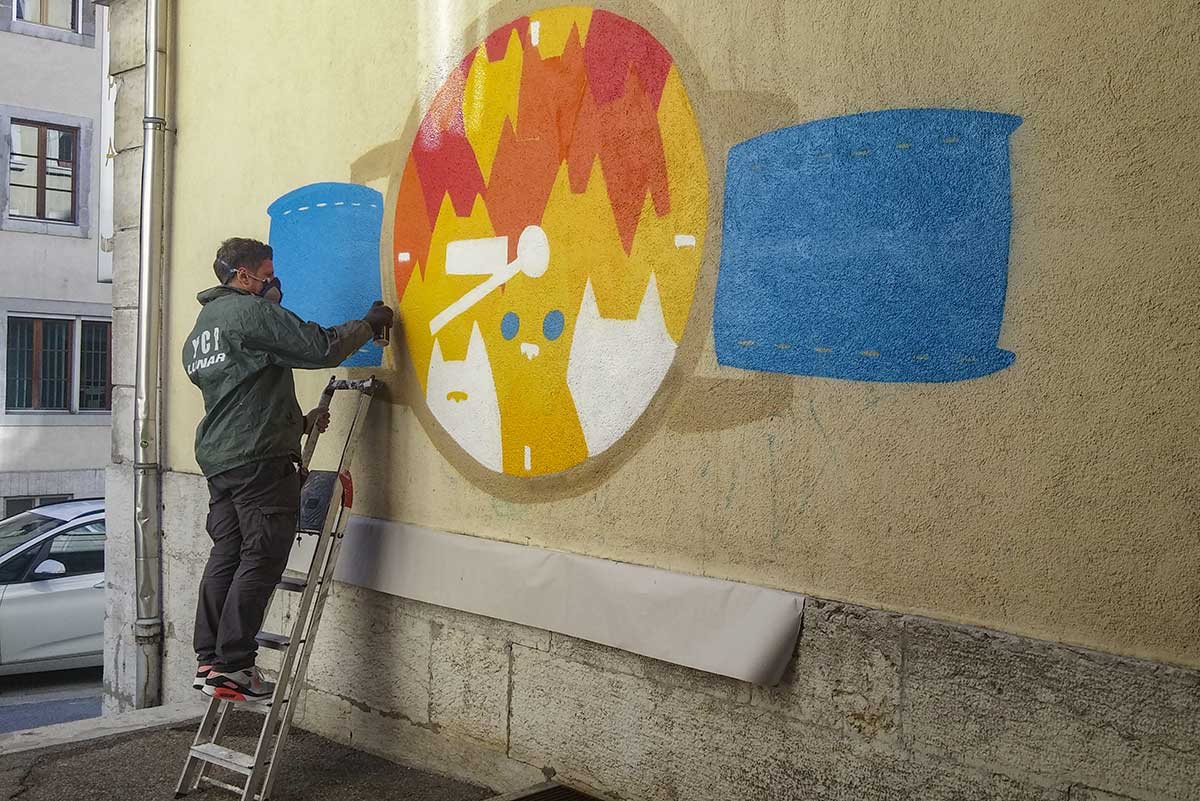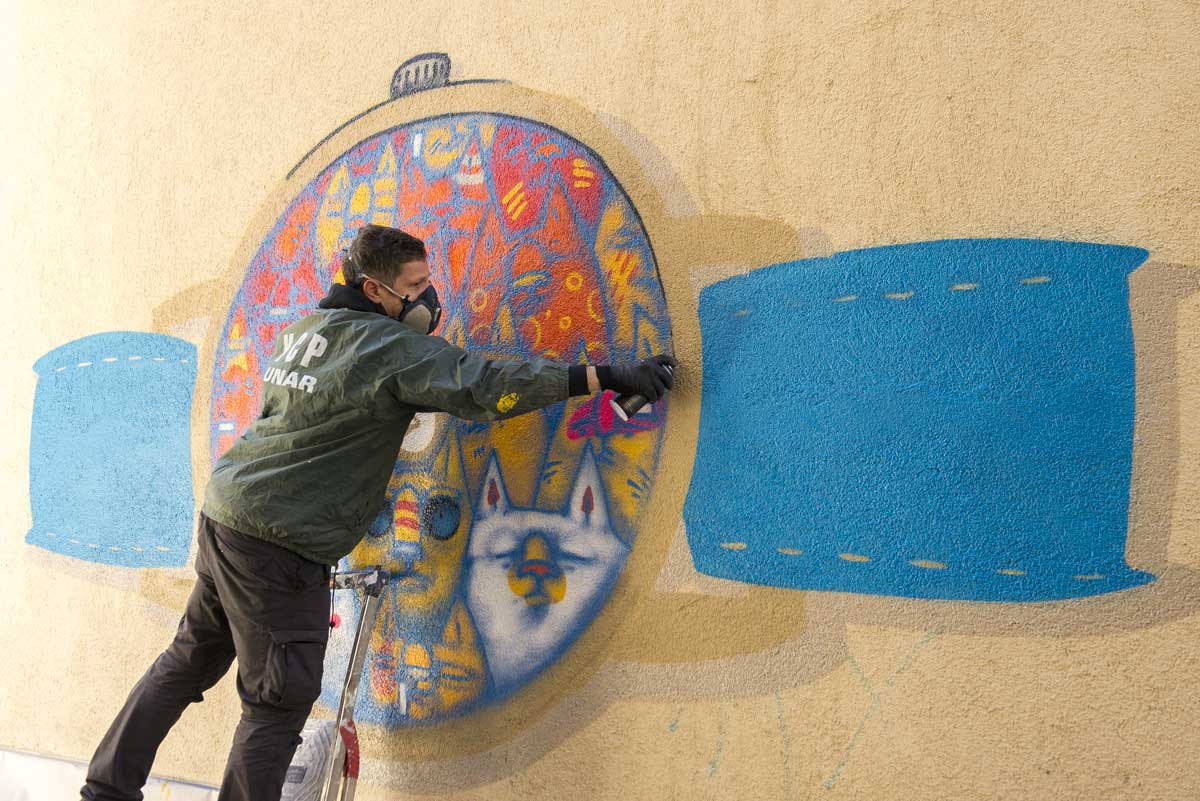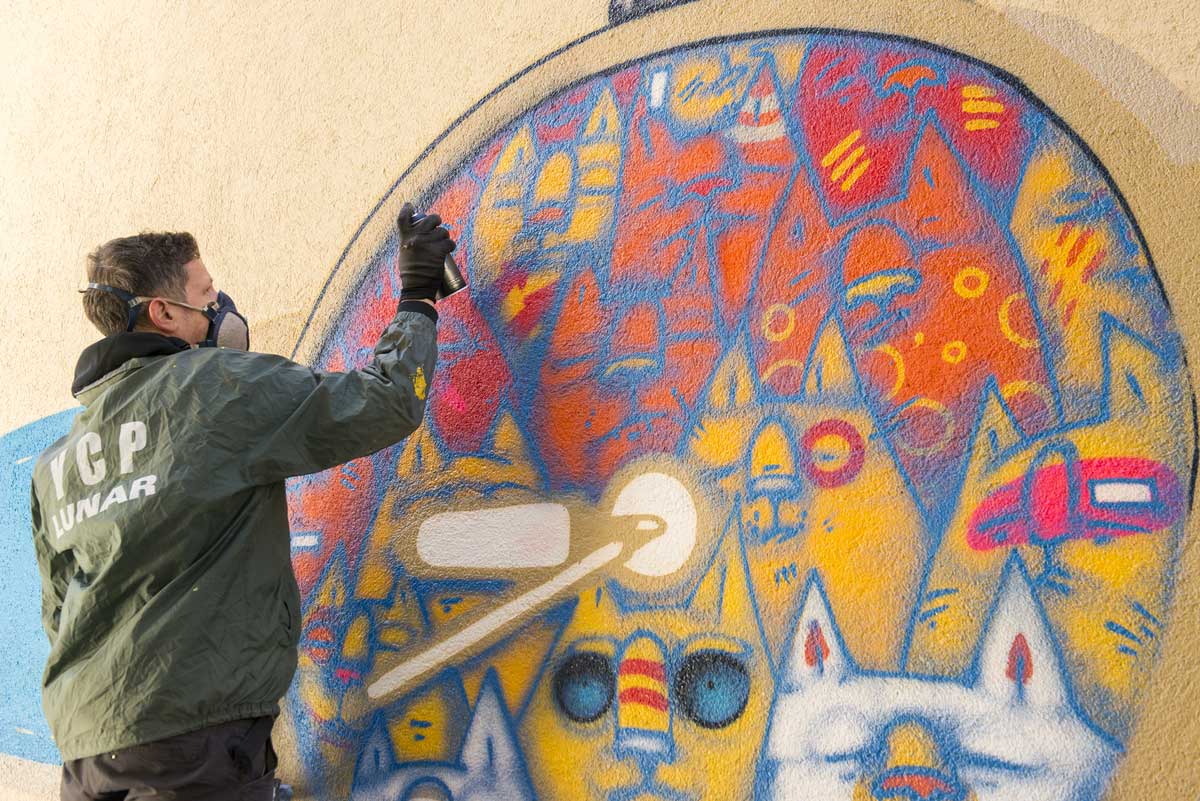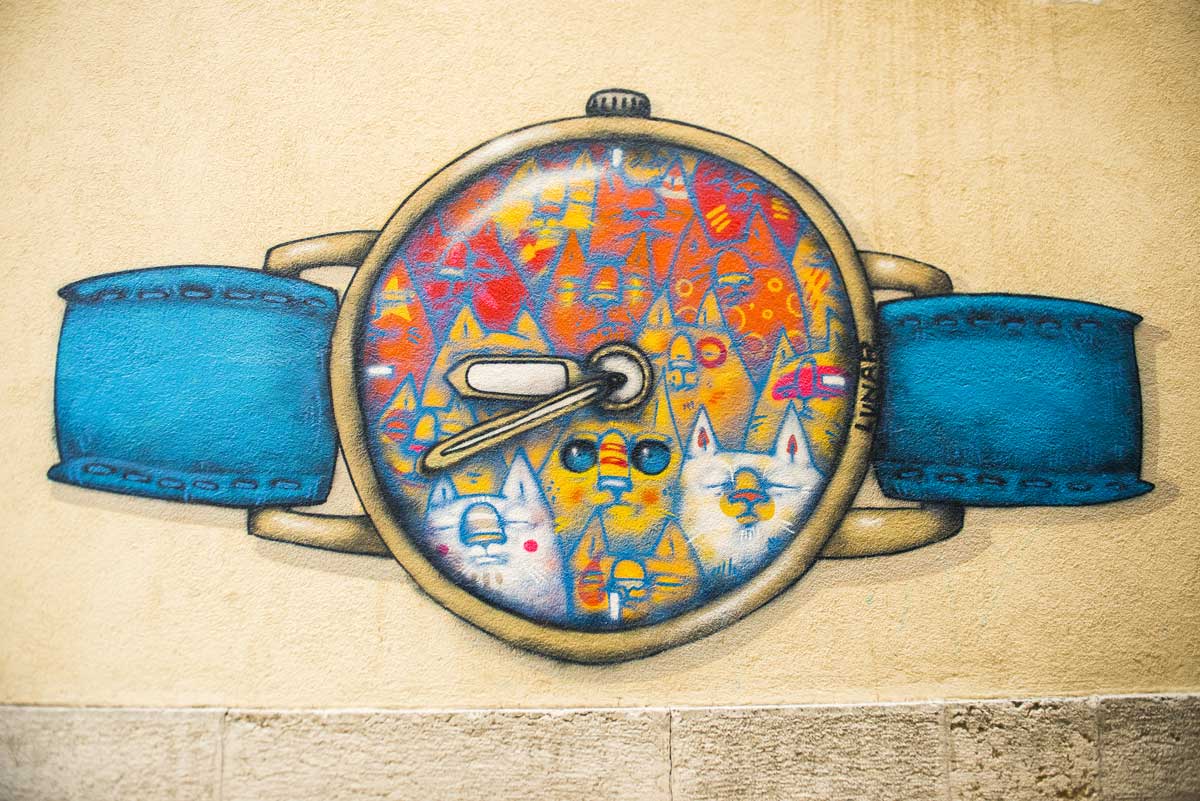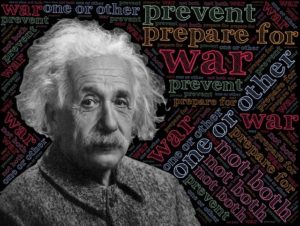Lunar
[HR]
- THE WORK -
Doomsday watch
Titre: Doomsday watch
Technique: Spray
YEAR CREATED: 2018
LOCATION: Grande-Rue 26
SURFACE AREA: 4 m2
With its coloured face featuring a cluster of cats looking like little old men, the wristwatch painted by Lunar, a leading light on the Croatian street art scene, might be a nod to the famous SWATCH brand, the collection of fun, original, robust and inexpensive Swiss watches that have enjoyed global commercial success since the early 1980s. However, the evocation of the local craft of watchmaking here is just a pretext for tackling a universal issue that is anything but glamorous: the looming threat of the self-inflicted extinction of humanity.
In keeping with his artistic concept – based on the dissemination of cats’ heads in the urban space – and his deceptively naive pictorial style, Lunar offers us his own interpretation of the Doomsday Clock. This conceptual watch serves as a barometer to illustrate international tensions likely to unleash nuclear war. It is a universally recognised indicator to evaluate the risk of the complete self-destruction of the human race following a global cataclysm.
Invented in 1947, i.e. at the start of the Cold War, the Doomsday Clock is the result of reflections by the Bulletin of the Atomic Scientists. This was a group of scientists set up in 1945 by Albert Einstein and members of the University of Chicago who participated in the Manhattan Project, the code name for the programme to develop the first atomic weapons that were dropped that year on the Japanese cities of Hiroshima and Nagasaki, bringing the Second World War to an end.
Shocked by the scenes and stories of devastation coming out of Japan, and aware of having opened Pandora’s box, the founders of the Bulletin of the Atomic Scientists decided to present an annual evaluation of the risks and likelihood of a global nuclear war. To make their research more accessible to the public, they came up with the idea of using a clock face and the notion of a countdown (to a nuclear explosion) to present, metaphorically, the level of danger. According to their concept, the apocalypse will take place at midnight on the dot. This choice of time is explained by being behind legends, ancient superstitions and contemporary anxieties (remember the Millennium Bug that was supposed to take place at midnight on 31 December 1999 with the fear of a global computer failure that was sure to plunge the planet into chaos). On the Doomsday Clock, the risk of apocalypse is in proportion to the hands’ distance from midnight. The risk increases as the clock hands approach the fateful time and, inversely, decreases when they move further away from it – because thankfully the hands can move anti-clockwise.
Twice a year, the Doomsday Clock is “set” by the Science and Security Board of the Bulletin of the Atomic Scientists, in consultation with its Board of Sponsors that includes 11 Nobel prize winners.
Since 2007, the calculation of risk has taken into account new threats caused by the resumption of the nuclear arms race, the emergence of new actors joining the old nuclear powers, the risk of war being triggered by a technical accident, an act of terrorism or a cyber attack, issues linked to climate change, shortages (of food or energy) and new technologies (nanotechnology, biotechnology) that could inflict irrevocable damage on the biosphere.
Multi-coloured and closely packed together, Lunar’s cats have their eyes shut. All but one, that is, who is watching the hands closely, aware that his existence depends on their progression. Feeling impotent, his fellow creatures prefer to close their eyes and forget those damned hands hanging over their heads like swords of Damocles. In this work, Lunar illustrates the denial of reality and collective flight. Confronted with a problem that is beyond them, humankind often prefer to look the other way and think of something else.
On Lunar’s watch, the time is 23.56. In 2018, when he created this mural, the artist showed himself to be “optimistic” because we were actually just two minutes from an apocalypse. And in the three years that followed, just 100 seconds away. Even at the height of the Cold War, “midnight” had never been as close as that. In 2022, with Russia’s invasion of Ukraine, that gap is sure to be even smaller. In 1991, the Doomsday Clock was 17 minutes before midnight thanks to the fall of the Berlin wall in 1989 and the dissolution of the Soviet Union.
Today the Doomsday Clock is part of popular culture, thanks especially to the US/British comic book series Watchmen (1986-1987, published by DC Comics / writer: Alan Moore / artist: Dave Gibbons / colourist: John Higgins). In 2009, these comic strips were made into a feature-length film entitled Watchmen, directed by Zack Snyder, before being adapted for the small screen in 2019.
> Link to the website of the Bulletin of the Atomic Scientists
Grande-Rue 26
ALBERT AND THE A BOMB
Although millions of us know that Albert Einstein played a role in the development of the atomic bomb, very few can say exactly what that role was. The scientist’s responsibility and his degree of involvement in this fateful undertaking have often been – and continue to be – overestimated by the public. Thus, during the second half of the 20th century, a persistent myth propagated the idea that Albert Einstein was “the father of the atomic bomb”. In fact, he had never been part of the notorious Manhattan Project, the programme to develop nuclear weapons. Its scientific lead was actually the American physicist J. Robert Oppenheimer. Attributing the paternity of such a titanic project to someone is evidently a shortcut in our thought processes and an oversimplification of history. So why does this idea persist?
E=mc2 + ATOMIC BOMB = confusion
The famous physicist is known throughout the world for his equation E=mc2 formulated in 1905. The irony is that this remains obscure to the average citizen and is confined to being a graphic symbol conveying notions of intelligence, genius and indescribable knowledge verging on magic. Nuclear physics is so complex that the science remains impenetrable for most people. Therefore, Einstein’s indirect scientific contribution to the Manhattan Project is beyond the understanding of the general public. In fact, while his theory of energy and mass being interchangeable properties, expressed by the equation E=mc2, paved the way for work on nuclear energy, the man behind it had no idea that some thirty years later it would be used to develop atomic weapons. It was only in 1939, when he learned that the Nazis had diverted his research for these ends, that Albert Einstein became aware of the destructive potential of nuclear fission.
THE LETTER THAT REMAINS A STAIN ON HIS REPUTATION
While on a scientific level Einstein had no direct involvement in the development of atomic weapons, he nevertheless endorsed their manufacture before issuing a retraction. Caught in a dilemma, this humanist and committed pacifist, who openly criticised racism, capitalism and war, paradoxically urged the United States to fund the manufacture of devastating weapons. Thus Einstein’s responsibility for the creation of the atomic bomb was political, not scientific. On 2 August 1939, influenced by Leó Szilárd, Edward Teller and Eugene Wigner, nuclear physicists who were convinced that Germany was going to develop nuclear weapons before the Allies, Einstein suddenly turned into a military strategist. Alarmed by the idea that the Nazis might make improper use of his theory of relativity, Albert Einstein signed a letter to US President Franklin Roosevelt, urging him to do everything in his power to enable the allied forces to win the race for the atomic bomb. Roosevelt took his advice, setting up the Advisory Committee on Uranium on 21 October 1939 with a small budget of $ 6,000. Einstein and Szilárd begged the American president to give them more money. The terrifying Manhattan Project had a modest start that year. In the end, realising the monstrousness of the enterprise, Einstein asked the President to stop the project, but was unsuccessful. Through his appeals, he attempted to warn mankind of the perils of nuclear proliferation, but the role he played in the creation of the Manhattan Project meant his words were barely heard.
REGRETS OF THE GENIUS
Although Albert Einstein never actually collaborated in any effective way on the scientific research undertaken as part of the Manhattan Project, his involvement in this lethal enterprise, although marginal, was nevertheless crucial and a source of guilt that led him to set up the Bulletin of the Atomic Scientists. During the official dinner to award the Nobel Prize in December 1945, so just a few months after the bombing of Hiroshima and Nagasaki, Einstein spoke about Alfred Nobel, saying that: “He invented an explosive more powerful than any then known – an exceedingly effective means of destruction. To relieve his conscience, he created the Nobel Prize.”
On 18 April 1955, as Albert Einstein – one of the greatest geniuses ever – lay on his deathbed, he spoke one last time about his regrets at straying from his pacifist values. He took his last breath fearing that his name would be forever be associated with the development of weapons of mass destruction.
- THE ARTIST -
LUNAR

Born in 1975, Slaven Kosanović, alias Lunar, lives and works in Zagreb. His artist name is a reference to Lunar Jetman, a videogame of the shoot ‘em up variety that was released in 1983. This multidisciplinary creator – street artist, graphic artist, philosopher, radio host and DJ in one – is among the first generation to popularise street art in Croatia. A leading light on the Balkan street art scene, Lunar enjoys an international reputation. His career has made him a key witness of the evolution of street art in Europe, from graffiti vandals of the 1980s to today’s neomuralists worshipped for their huge murals.
The seeds of the “Lunar” adventure were sown in 1989 when the young Slaven merrily emptied his first can of spray paint. Having dreamt until then of becoming a famous palaeontologist or like someone in the mould of David Attenborough, deep down he heard a small voice that promised him a long career as an artist. He was bitten by the graffiti bug. When he was barely any more than fourteen, the teenager from Zagreb craved different horizons and wanted to meet people who inspired him and shared his utopian dreams. He took his rucksack and headed off to conquer other cities in Croatia and then Europe. During this nomadic time, he built up a network throughout Europe, establishing links with a crowd of artists, painters, musicians and visual artists. As an ambassador of the Croatian street art scene, he attracted several artists to his homeland and served as their guide during their artistic travels. With his friend Krešimir Buden, in 1992 he set up the graffiti-hip-hop group Yo Clan Posse (YCP), later known as Young Croatian Playboys or Your Cheeky Pals. Accustomed to creating collective works, he painted his first solo graffiti in 1993, which marked an important stage in his career.
In the mid-1990s, Slaven Kosanović embarked on graphic art to expand the fields of his creativity while pursuing his approach as a street artist, mostly settling in his hometown of Zagreb. Commissioned by leading brands and major clients, his career really took off. From 2000 to 2010, he worked as a designer at Hyper Studio, then for the agency McCann Erickson. In 2003, he became a member of the Croatian Association of Artists of Fine Arts (ULUPUH) and in the same year set up the association HHH (Croatian Hip Hop). For five consecutive years, he helped run the world’s largest graffiti festival, Meeting of Styles, which was held in some fifteen countries. In 2009, Lunar set up his own company Lunar dizajn.
Over the years, Lunar has acquired an international reputation painting, exhibiting and publishing his works in several countries. Murals bearing his tag decorate walls in Amsterdam, Athens, Auckland, Berlin, Hanoi, Havana, Lisbon, London, Melbourne, New York, Oslo, Paris, Saigon, Seoul, Sydney and Tokyo, to mention just some of the largest cities. His work has merited articles written for prestigious magazines and reviews and is mentioned in a number of books on street art. In 2019, he created the book From Zagreb with Love, a magnificent retrospective on his career as an artist. His book launch was held in Amsterdam’s Street Art Museum.
Through his blending of pictorial codes, Lunar creates eclectic works, often figurative and sometimes abstract, in which typography happily makes an appearance, testifying to his great passion for graffiti. The cat is practically omnipresent in his work. The artist has chosen it as his mascot because he thinks that no other animal incarnates the world of street art better than this cute predator that roams the streets. According to him, graffiti artists and alley cats have the same character traits: “they are confident, cheeky and independent”. Among the other things they have in common, he cites their attraction to wasteland, heights and poorly lit streets, their stealth, their desire to appropriate territory and the fact that they set their own rules. In creating Catso, a cat that he anthropomorphises and is continually reinventing, Lunar has created a kind of feline alter ego.
Before Lunar, others have chosen the cat to symbolise rebelliousness. For example, the revolutionary trade unionists of the IWW (Industrial Workers of the World) used the symbol of the black cat as a code to incite workers to take direct action in factories. The feline with bristling fur was then adopted by anarchists and the CNT (National Confederation of Labour). Over the years, a growing number of radical movements and militant organisations have appropriated it as their symbol – a mascot of working class militancy.
To print the content of the page, please click on the printer icon.
- The exo -
on the web
Thank you for following and supporting the exomusée on Facebook, Instagram and YouTube!

